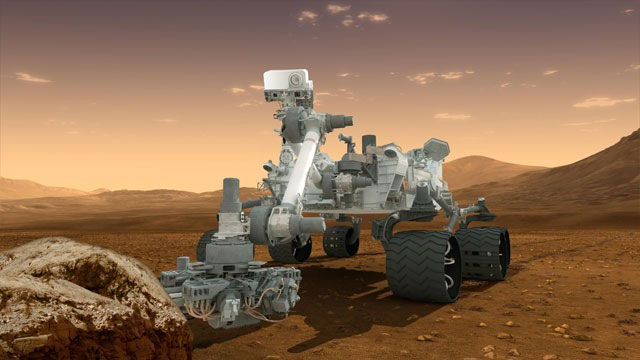What mystery of Mars awaits discovery?
Mars, the closest neighbor of the Earth in the solar system, still harbored a myriad of secrets that scientists crave to discover.
With the latest Mars explorer Curiosity going to officially land on Mars's surface, NASA hopes to 'unlock' many of them.
As the heart of the ship and Mars Science Laboratory, the Curiosity exploration robot is equipped with a series of special tools to not only study the surface of Mars today but also to dig into that surface in too the past.
For a long time, the overall strategy of NASA's exploration of Mars is still a trace of water, and Curiosity is no exception. Based on the clues left by previous missions, this latest probe will seek answers to a series of questions about the Martian climate and geology. And of course, it will have to find evidence of whether there has ever been life on the red planet.

Curiosity will have to answer a series of tough questions about the red planet.
1. Where can life be found?
Curiosity will not seek life directly, because that task requires more sophisticated scientific equipment, much more modern than automatic probes. Therefore, Curiosity will only search for places where life may have evolved.
Because water is considered an essential element for the development of life on Earth, scientists will focus on wet areas on Mars, both past and present.
In addition, an 'livable' environment will have the presence of an energy source that microbes can use to live and evolve. In addition, it must have signs of organic carbon.
2. Why does a wet Mars become dry?
In the distant past, Mars was warmer and more likely to possess a thicker, wetter atmosphere, with water crept across the surface of the planet. But today, the red planet is arid, full of sand dust and most of the water is believed to have been trapped deep in the ground.
Curiosity will land on Sharp peak, about 5 miles from the center of Gale Hole. This mountain has many levels for Curiosity to step by step to explore. NASA described Sharp's floors as pages of a book, with the first floor like the oldest chapters. Curiosity's mission is to discover Mars 'embedded' within the rock.
At the same time, it will study the geological shift on the Red Planet over millions of years.
Finally, it will analyze the composition of the Martian climate today, measure air temperature, ground, wind movement. Combined with measurements from the Mars Science Laboratory, NASA will be able to get a more comprehensive view of the Martian climate.
- The mystery of little knowledge about winter technology awaits revival
- NASA is about to announce the discovery of a tremor about Mars
- The journey to discover Mars of humankind
- NASA has discovered the geological mystery on Mars
- Water flows on Mars - the discovery changes the cosmic perception
- Latest Mars map
- The 'weird' shapes continue to appear on Mars
- Curiosity's ability to find life on Mars is decreasing
- Detecting aliens home on Mars?
- Mars can nourish life
- Why is it important to find methane gas on Mars?
- New discovery of life survival under the surface of Mars
 Van Allen's belt and evidence that the Apollo 11 mission to the Moon was myth
Van Allen's belt and evidence that the Apollo 11 mission to the Moon was myth The levels of civilization in the universe (Kardashev scale)
The levels of civilization in the universe (Kardashev scale) Today Mars, the sun and the Earth are aligned
Today Mars, the sun and the Earth are aligned The Amazon owner announced a secret plan to build a space base for thousands of people
The Amazon owner announced a secret plan to build a space base for thousands of people Was there nuclear war in ancient times?
Was there nuclear war in ancient times?  What happens to dead bodies on Mars?
What happens to dead bodies on Mars?  Watch NASA probe 'capture' Martian sandstorm
Watch NASA probe 'capture' Martian sandstorm  First photo of Mars' strangely shaped moon
First photo of Mars' strangely shaped moon  What makes Mars different from Earth
What makes Mars different from Earth  How will humans build on Mars?
How will humans build on Mars? 